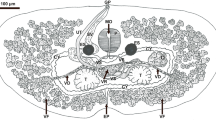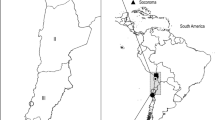Abstract
Ribosomal DNA sequences of the second internal transcribed spacer (ITS-2) and 28S ribosomal DNA (618 bp) of Fasciola gigantica collected from cattle and buffaloes from four different geographical locations of India, were characterized for genotyping. ITS-2 sequence was analyzed in 28 worms that was typical of F. gigantica and differed at six positions, with one of these being a distinguishing deletion (T) at the 327th position in F. gigantica relative to F. hepatica. However, Fasciola specimens also showed intraspecies sequence polymorphism in the ITS-2, with two different ITS-2 sequences existing in the ribosomal DNA (rDNA) array within a single Fasciola worm. One of the sequences was identical to that of F. gigantica and the other showed extensive sequence polymorphism in the ITS-2. Using BspH1-restriction fragment length polymorphism, six variable ITS-2 sequences in F. gigantica were identified within these parasite specimens and were found distributed in these four geographical regions. 28S rDNA sequence of 24 flukes, collected from the above four geographical regions, showed a single nucleotide polymorphism at 284th nucleotide (G/A). Analyzing the sequence data of 28S rDNA of F. gigantica available from some African and Asian countries for this polymorphic 284th nucleotide position, it is proposed that there are two basic lineages of the F. gigantica for 28S rDNA existing in the fluke populations from five African and several Asian countries.



Similar content being viewed by others
References
Agatsuma T, Arakawa Y, Iwagami M, Honzako Y, Cahyaningsih U, Kang SY, Hong SJ (2000) Molecular evidence of natural hybridization between Fasciola hepatica and F. gigantica. Parasitol Int 49:231–238
Ali H, Ai L, Song HQ, Ali S, Lin RQ, Seyni B, Issa G, Zhu XQ (2008) Genetic characterization of Fasciola samples from different host species and geographical localities revealed the existence of F. hepatica and F. gigantica in Niger. Parasitol Res 102:1021–1024
Ashrafi K, Valero MA, Panova M, Periago MV, Massoud J, Mas-Coma S (2006) Phenotypic analysis of adults of Fasciola hepatica, Fasciola gigantica and intermediate forms from the endemic region of Gilan, Iran. Parasitol Int 55:249–260
Douady CJ, Delsuc F, Boucher Y, Doolittle WF, Douzer EJ (2003) Comparison of Bayesian and maximum likelihood bootstrap measures of phylogenetic reliability. Mol Biol Evol 20:248–254
Gunasekar KR, Tewari AK, Sreekumar C, Gupta SC, Rao JR (2008) Elucidation of genetic variability among different isolates of Fasciola gigantica (giant liver fluke) using random-amplified polymorphic DNA-polymerase chain reaction. Parasitol Res 103:1075–1081
Huang WY, He B, Wang CR, Zhu XQ (2004) Characterization of Fasciola species from Mainland China by ITS-2 ribosomal DNA sequence. Vet Parasitol 120:75–83
Hurtrez-Bousses S, Durand P, Jabbour-Zahab R, Guegan JF, Meunier C, Bargues MD, Mas-Coma S, Renaud F (2004) Isolation and characterization of microsatellite markers in the liver fluke (Fasciola hepatica). Mol Ecol Notes 4:689–690
Itagaki T, Kikawa M, Terasaki K, Shibahara T, Fukuda K (2005a) Molecular characterization of parthenogenic Fasciola sp. in Korea on the basis of DNA sequences of ribosomal ITS1 and mitochondrial NDI gene. J Med Vet Sci 67:1115–1118
Itagaki T, Kikawa M, Sakaguchi K, Shimo J, Terasaki K, Shibahara T, Fukuda K (2005b) Genetic characterization of parthenogenic Fasciola sp. in Japan on the basis of the sequences of ribosomal and mitochondrial DNA. Parasitology 131:679–685
Itagaki T, Sakaguchi K, Terasaki K, Sasaki O, Yoshihara S, Van Dung T (2009) Occurrence of spermic diploid and aspermic triploid forms of Fasciola in Vietnam and their molecular characterization based on nuclear and mitochondrial DNA. Parasitol Int 58:81–85
Le TH, De NV, Agatsuma T, Nguyen TGT, Nguyen QD, McManus DP, Blair D (2008) Human fascioliasis and the presence of hybrid/introgressed forms of Fasciola in Vietnam. Int J Parasitol 38:725–730
Lin RQ, Dong SJ, Nie K, Wang CR, Song HQ, Li AX, Huang WY, Zhu XQ (2007) Sequence analysis of the first internal transcribed spacer of rDNA supports the existence of the intermediate Fasciola between F. hepatica and F. gigantica in mainland China. Parasitol Res 101:813–817
Marcilla A, Bargues MD, Mas-Coma S (2002) A PCR-RFLP assay for the distinction between Fasciola hepatica and Fasciola gigantica. Mol Cel Probes 16:327–333
Peng M, Ichinomiya M, Ohtori M, Ichikawa M, Shibahara T, Itagaki T (2009) Molecular characterization of Fasciola hepatica, Fasciola gigantica, and aspermic Fasciola sp. in China based on nuclear and mitochondrial DNA. Parasitol Res 105:809–815
Prasad PK, Tandon V, Biswal DK, Goswami LM, Chatterjee A (2008) Molecular identification of the Indian liver fluke, Fasciola (Trematoda: Fasciolidae) based on the ribosomal internal transcribed spacer regions. Parasitol Res 103:1247–1255
Prasad PK, Tandon V, Biswal DK, Goswami LM, Chatterjee A (2009) Use of sequence motifs as barcodes and secondary structures of internal transcribed spacer 2 (ITS2, rDNA) for identification of the Indian liver fluke, Fasciola (Trematoda: Fasciolidae). Bioinformation 3:314–320
Prasad PK, Goswami LM, Tandon V, Chatterjee A (2011) PCR-based molecular characterization and in silico analysis of food-borne trematode parasites Paragonimus westermani, Fasciolopsis buski and Fasciola gigantica from Northeast India using ITS2 rDNA. Bioinformation 6:64–68
Sanyal PK (2004) Control of tropical fasciolosis in cattle and buffaloes in India at the backdrop of its integrated management. J Vet Parasitol 15:13–16
Semyenova SK, Morozova EV, Chrisanfova GG, Asatrian AM, Movsessian SO, Ryskov AP (2003) RAPD variability and genetic diversity in two populations of liver fluke, Fasciola hepatica. Acta Parasitol 48:125–130
Semyenova SK, Morozova EV, Vasilyev VA, Gorokhov VV, Moskvin S, Movsessyan SO, Ryskov AP (2005) Polymorphism of internal transcribed spacer 2 (ITS-2) sequences and genetic relationships between Fasciola hepatica and F. gigantica. Acta Parasitol 50:240–243
Semyenova SK, Morozova EV, Chrisanfova GG, Gorokhov VV, Arkhipov IA, Moskvin AS, Movsessyan SO, Ryskov AP (2006) Genetic differentiation in Eastern European and Western Asian populations of the liver fluke, Fasciola hepatica, as revealed by mitochondrial nad1 and cox1 genes. J Parasitol 92:525–530
Sharma RL, Dhar DN, Raina OK (1989) Studies on the prevalence and laboratory transmission of fascioliasis in animals in the Kashmir Valley. Brit Vet J 145:57–61
Teofanova D, Kantzoura V, Walker S, Radoslavov G, Hristov P, Theodoropoulos G, Bankov I, Trudgett A (2011) Genetic diversity of liver flukes (Fasciola hepatica) from Eastern Europe. Infect Genet Evol 11:109–115
Terasaki K, Moriyama-Gonda N, Noda Y (1998) Abnormal spermatogenesis in the common liver fluke (Fasciola sp.) from Japan and Korea. J Vet Med Sci 60:1305–1309
Vara-Del Rıo MP, Villa H, Martinez-Valladares M, Rojo-Vazquez FA (2007) Genetic heterogeneity of Fasciola hepatica isolates in the northwest of Spain. Parasitol Res 101:1003–1006
Varma AK (1953) On Fasciola indica n.sp. with some observations on Fasciola hepatica and Fasciola gigantica. J Helminth 27:185–198
Walker SM, Prodohl PA, Fletcher HL, Hanna REB, Kantzoura V, Hoey EM, Trudgett A (2007) Evidence for multiple mitochondrial lineages of Fasciola hepatica (liver fluke) within infrapopulations from cattle and sheep. Parasitol Res 101:117–125
Acknowledgments
The authors are thankful to the Director, Indian Veterinary Research Institute, Izatnagar for providing financial support for this research work. We are also thankful to Mr. Ashok Kumar Mishra for his technical assistance in this work.
Author information
Authors and Affiliations
Corresponding author
Rights and permissions
About this article
Cite this article
Raina, O.K., Jacob, S.S., Sankar, M. et al. Genetic characterization of Fasciola gigantica from different geographical regions of India by ribosomal DNA markers. J Parasit Dis 39, 27–32 (2015). https://doi.org/10.1007/s12639-013-0276-7
Received:
Accepted:
Published:
Issue Date:
DOI: https://doi.org/10.1007/s12639-013-0276-7




